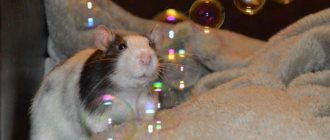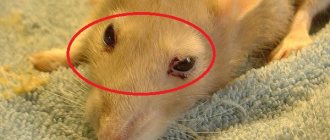Rats have gotten a bad reputation as "unclean" animals that frequent drains and dark places. While wild rats end up in some unsavory situations, rats bred specifically as pets are a different matter. Pet rats have many attractive qualities that can make them great companions for children, adults and the elderly.
Teeth grinding
This phenomenon usually accompanies the bulging of the eyes described above. There is no need to be scared, the rat belongs to the rodent family, and its teeth are constantly growing. When a rat grinds its teeth, it tries, so to speak, to moderate their growth, to make sure that they do not grow too quickly. Moreover, teeth grinding in rats is similar to purring in cats - this is what they do in moments of relaxation and peace. This creates vibrations that help the eyeball protrude - therefore, these two phenomena are interrelated. At the same time, a rat may grind its teeth when it is scared or in pain, so pay attention to the circumstances under which this happens (for example, when you pet it or vacuum near the cage).
Original publication: 10 Common Rat Behaviors. Author: Laura Doering.
How to understand a rat?
Watch a rat for twenty minutes and the complex world of its character will open up to you.
If you want to buy an animal, watch how it communicates with its relatives, and you will understand whether it is a bully or calmly shares food with its comrades. Each rat has its own personality, but there are some common actions that all rats use to express happiness or displeasure. Once you learn to recognize them, it will become easier for you to understand your pet's complex nature.
Rats are social animals. They love to sleep cuddled up to each other, quarrel over crumbs, play and playfully fight. Your pet will feel happier with its relatives, even if you pamper it.
Rats generally trust their owners and actively seek their attention. This sets them apart from other small pets, such as hamsters, which tolerate human company rather than enjoy it.
After watching a group of cheerful, healthy rats, you will see how they lick and stroke each other's ears, fur, noses and tails. Mutual grooming is a manifestation of a warm relationship, a reminder of childhood and maternal affection. And you should know that if your rat starts licking your fingers or hair, then this is a compliment for you . She's trying to express how much she cares about you, not bite your finger off.
When rats are happy, they grind their teeth. This behavior is often compared to the purring of cats. You may not notice this quiet sound until your rat climbs onto your shoulder at ear level. This squeak causes a vibration that travels through the entire body, causing a slight trembling. This creaking noise, which expresses happiness, should not be confused with the clicking of teeth, which is a sign of excitement. Your pet's body language should tell you his state of mind.
If the fur on its back stands on end, or the whole body is tense, the eyes sparkle angrily and look at one point, then the rat is definitely excited about something. A rat may make squealing or hissing noises when attacked by another. If your rat shows anger towards another rat in the colony, move it to another cage and give it time to calm down.
Dominant rat. Typically, rats establish a hierarchy in their community in a playful manner. Add a new animal to the colony, and you will witness a whole performance. After sniffing and a short struggle, the weaker rat may find itself laid down on both shoulder blades. She will have no serious wounds, except for her wounded pride. The squeaks and squeals that you hear during such a “game” are simply exclamations of encouragement for yourself and intimidation of the enemy, and not manifestations of rage. Separate the rats if one bites the other hard enough to bleed.
It's important to take time to observe your pets every day so you can quickly recognize any antisocial behavior. If one of your pets seems lethargic, refuses food, or sits alone, there is probably something wrong with it. Contact a veterinarian who specializes in small mammals as soon as possible.
Copyright holder: Zoo Club portal When reprinting this article, an active link to the source is MANDATORY, otherwise, use of the article will be considered a violation of the Law on Copyright and Related Rights.
Can drive a car
The extraordinary nature of these animals is also evidenced by an experiment recently conducted by scientists from the University of Richmond - the team of Professor Kelly Lambert, who built small cars.
The chassis and drivetrain were made from a robot car kit, and a clear plastic food container became the body. Explaining the idea of a steering wheel and pedals to the rats was too difficult. Therefore, management has been simplified. The rat had to stand on the plate and grab the copper rod - due to this, the circuit was closed and the engines turned on.
It's a paradox - but rats learned to drive a car. Three five-minute sessions per week for eight weeks were sufficient. Naturally, treats were also used. It is characteristic that those who had previously lived in a complex environment - multi-level cages with different objects for games - were more trainable.
A rat is taught to drive a car.
arstechnica.com
Character of decorative rats
Rats are social rodents
If you think that all rodents have the same character, and they are all carbon-copy similar to each other in their behavior, you are mistaken. Just as there are no absolutely two identical people, there are absolutely no two identical decorative rats. And, this applies not only to their appearance, but also to their inner world. There are general behavioral features characteristic of the species, but each decorative rat has its own character.
It is quite obvious that when you come to a pet store and want to choose a pet, you still don’t know anything about it or its character. In order for you to make a first impression (which, however, can also be wrong), we suggest that you spend a few minutes of your time observing the behavior of the rat in its usual environment. How does she behave with her relatives, how does she eat, is she constantly on the move or does she prefer to sit in the corner of the cage? All this will allow you to get at least a general idea of the character of your future pet.
LEARNING TO UNDERSTAND THE LANGUAGE OF RATS
Just 20 minutes of reading and you will better understand the character of your rat. If the rat you are going to buy communicates with other rats of its age, then you will see whether it is a local bully or is happy to share food with others. You will understand that every rat is an individual, but there are also some behavioral characteristics that can help you understand the rat's language of happiness or sadness. Understanding a rat's language is as easy as deciphering its behavior and signs.
Rats are social animals Rats are very social. They love to sleep in a single ball, compete for treats and just go crazy together. Your pet may be happier with other rats, although most rats love to interact with people. They have learned to trust people and constantly seek communication with them. This is what sets them apart from other small animals, such as hamsters, which tend to treat people with indifference rather than affection. If you hang out with a happy, healthy group of rats, you will find them licking and grooming each other's ears, fur, noses and tails. General grooming shows the rats’ good relationship with each other, a reminder of youth and the mother rat caring for her babies. Grooming rats are happy animals, and you should take it as a compliment if your rat starts licking or grooming your fingers or hair during quiet time together. The rat is trying to woo you, not bite your hand. Rats grind their teeth when they are happy. Rats may also grind their teeth when they are happy. This behavior is most often called rat purring, i.e. the same as a cat purring. At first, you may not hear such purring until the rat climbs onto your shoulder at ear level. When a rat purrs, it may seem that the vibration is going throughout its entire body. But purring should not be confused with warning sounds when rats are aggressive towards each other. I think that depending on the situation you can determine whether your rat is aggressive or not.
Game rules and safety
Before starting active games with a decorative rat, you will need to mentally prepare the animal for joint leisure, and also study the basic safety rules. In order for all participants in entertainment events to feel comfortable, it is necessary to adhere to several recommendations:
- When choosing a game, you need to take into account the character of the rat. For example, some animals love exploration - they constantly sniff everything around, looking into secluded corners. Others prefer active physical activity, running in a wheel, climbing ladders and ropes, and overcoming obstacles. Still others like to relax in a cozy house, sleep, and only occasionally frolic with their cage neighbors. Having carefully studied your pet's character, you will be able to select quests that are most interesting specifically for him.
- During play, it is better to choose a role for the rat that matches its natural instincts. In its natural environment, the rat acts as a hunter. But when meeting larger animals, it usually plays the role of a victim. In both cases, the animal has to run a lot (to run away or catch up) and engage in battle with the enemy.
- When playing outside the cage, you will need to lock all doors and windows in the room, and also limit the animal's access to electrical wires. This is necessary for the safety of the animal.
- It is not recommended to start entertainment unexpectedly for your pet. The start of the game should be announced loudly each time, using the same words. For example, “Fluffy, it’s time to frolic!” In addition, signals from the rat itself about the desire to play cannot be ignored. If an animal, upon seeing its owner, begins to playfully run around the cage or takes its favorite toy, it is worth supporting the animal’s initiative.
- As a play area, it is better to choose a floor that is not cluttered with furniture and other household items (floor vases, musical instruments, boxes).
- During active games, you need to remember that the rat is a fragile animal. Therefore, you need to act more carefully with the animal - do not squeeze its body, do not lift it into the air by its paws, and especially do not pull its tail.
It is also necessary to remember that decorative rats get tired quite quickly. Therefore, they cannot frolic for hours on end. The optimal duration of joint games is 10-20 minutes. 2-3 approaches per day will be more than enough.
It can be gigantic
An ordinary person understands a rat as the most common species on the planet - the Norwegian, or gray (Pasyuka), and its domesticated relative, which is bred in homes.
There are legends that these creatures grow almost to the size of a cat. This is not true - pasyuki do not grow. The largest of them rarely reach 50 centimeters including the tail and gain 450 grams.
But... In nature, there is not only this type of rat. In New Guinea, during the filming of a BBC nature film in 2009, a completely new species was discovered in the crater of the Bosavi volcano.
It was named the Bosavi woolly rat. This miracle of nature reaches 82 centimeters (including the tail). This “rat” weighs about 1.4 kg. And she is not at all afraid of a person whom she has never seen during her volcanic life.
Rat.
creativecommons.org
Rat.
creativecommons.org
Rat.
visualhunt.com
Extraordinarily loving
But no matter how many rats humanity destroys, there are not just a lot of them, there are a lot of them. Of course, no one is conducting a census of the “rat population”. But biologists have their own methods of counting.
And so they say: in warm countries there are 3-4 rats per person (and some believe as many as 9!). And in New York the ratio is one to one. So think about who is our king of nature - a man or a rat.
Rat.
creativecommons.org
And why all? These rodents are extremely fertile and loving. They have the ability to give birth to babies already at the age of three months, although they usually “puppy” (or “rat”?) closer to a year.
And during the fertile period they mate up to 500 times (!) with different gentlemen. Three weeks after this exciting activity, from 6 to 20 babies are born. According to some estimates, in just 2-3 years of its short life, a rat is capable of producing up to 6 thousand offspring. And each of these “fruits of love” will also produce no less - just give it.
Moreover, they are not threatened with hunger: in warehouses and in human cellars there is always something to profit from.
Rat.
visualhunt.com
Suspected of destroying dinosaurs
What can I say, a rat is a bad neighbor for a person. She is not afraid of ruining her figure, and besides, she is not capable of starving (3-4 days without food is a death sentence for her). Therefore, he is always looking for something to snack on. In a year, she can eat up to 10 kg of food. And spoil it even more.
Many years ago, Americans conducted an experiment: in a food warehouse they gave rats complete freedom for two months. It is possible that after summing up the results they had to take large doses of sedatives.
It turned out that the rodents ate or spoiled hundreds of bags of coffee, 14 tons of flour, 200 tons of sugar and all the packs of pasta right from the cardboard packaging.
Scientists now strongly suspect that rats are to blame for the extinction of dinosaurs: they could well have sucked out the contents of laid eggs, thereby ending the glorious line of ancient reptiles. However, this is only a version, and it is not at all necessary to believe it.
Rat.
visualhunt.com











